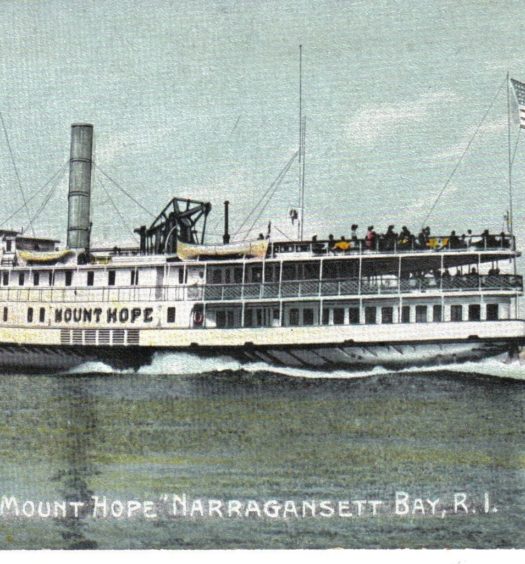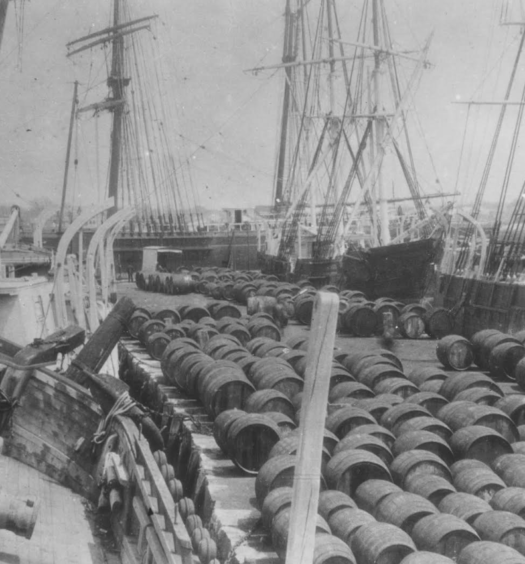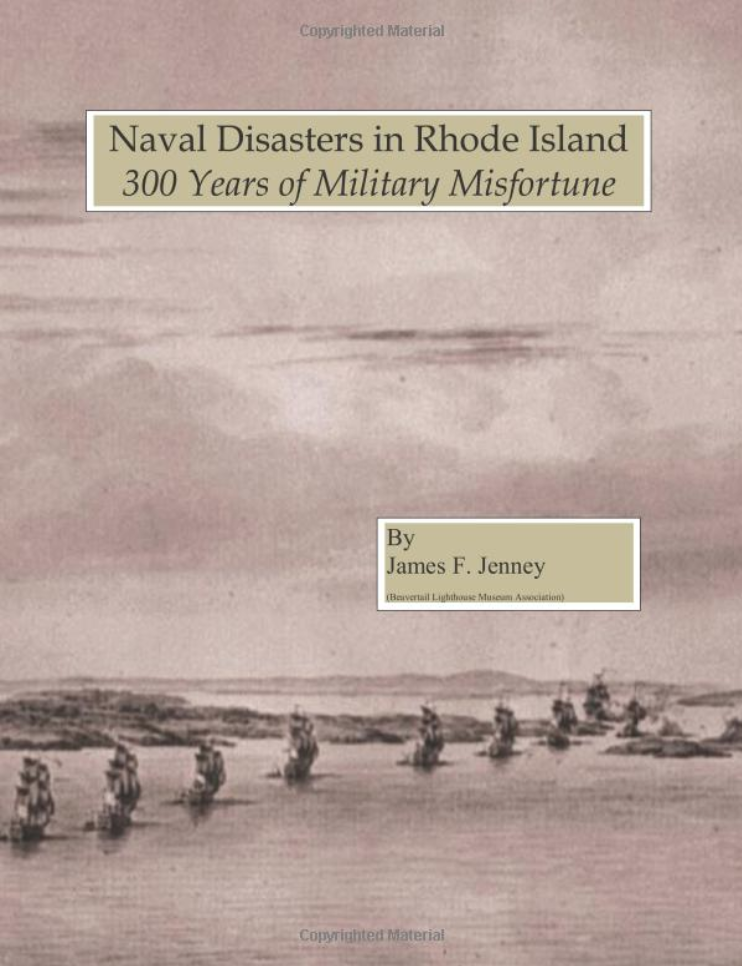Rhode Island has a rich history intimately involved with maritime interests of every type from local fishermen to international commercial traders. And, as might be expected, as the number of vessels in state waters increased, the number of marine disasters increased as well. In my study of marine disasters throughout state waters, it has become clear that some specific sites are more dangerous than others. That fact was the cornerstone upon which the decision to write a complete set of articles about these sites was based. In all, there are thirteen sites that represent the greatest threat to mariners in Rhode Island waters.
Of all of these sites in the state, the immediate waters around Watch Hill Point and its offshore reefs, are the most dangerous in terms of vessels totally lost or wrecked. There are other areas where more have met with disaster but none where the number of totally wrecked vessels is greater. In successive articles, other specific sites will be highlighted.
Situated at the western end of the state, Watch Hill is a prominent though small point of land that juts out into Block Island Sound at the eastern end of Long Island Sound. Watch Hill serves as one boundary of Fishers Island Sound with the eastern point of Fishers Island being the opposite boundary. Between those two points lie a large number of reefs with only narrow passages where vessels can enter Fishers Island Sound from the eastward. There are no major ports in the immediate vicinity of Watch Hill but the passage into Fishers Island Sound is the normal route taken for vessels from northern ports headed for Stonington, Connecticut. A prominent concern to mariners in this area is the strong currents and tidal flow where the two sounds converge. When augmented by seasonal fogs, navigation in this area is challenging at best.
This article will treat as Watch Hill the immediate shore adjacent to Watch Hill Point, Watch Hill Reef, and, slightly to the west, Catumb Rocks. In this small area 49 vessels have been totally lost over the years, from as small as a 16-ton fishing boat named AKBAR to a 2,700-ton steamship, the ONONDAGA. Although the list of wrecks is made up predominantly of schooners, there are other, variously rigged, sailing vessels, two steam vessels and a couple of barges on the loss list.
The following is a list of the vessels that have ended their careers on the rocks on or just off Watch Hill Point. A brief overview of each of the vessels lost is offered below. Further information on all the wrecks can be found at the museum at Beavertail Lighthouse in Jamestown, where a complete database of the marine disasters in Rhode Island is available and accessible to the general public.
- July 26, 1776. British ship NATHANIEL AND ELIZABETH ran ashore on a reef of rocks near Watch Hill during the American Revolutionary War. The vessel originally left a British Caribbean island bound for London, England, with a cargo of rum, sugar and other items. It had been captured by the American brig ANDREW DORIA and was being brought in as a prize when the British 28-gun frigate CERBERUS chased her ashore. The CERBERUS’s captain dared not approach the shore with his larger vessel with a deeper draft for fear of joining the stranded ship in her perilous position so they left the scene and the wreck behind. Locals quickly came to the site with the intent of rescuing the ship or at least retrieving the cargo. They were partly successful. Nearly all of the rum (100 hogsheads) and a small portion of the sugar was saved, but the vessel went to pieces where she lay.
- September 22, 1777. Also during the American Revolutionary War, Royal Navy armed schooner ADMIRAL PARKER ran ashore on Watch Hill Reef. ADMIRAL PARKER was headed from Gardiners Island in Long Island Sound to Newport, in a fleet of about twenty other vessels. While attempting to capture a small American privateer sloop that was inbound for Stonington, the schooner’s master miscalculated and ran hard aground on the reef. Under fire by cannon manned by Rhode Island militia from the shore, the ADMIRAL PARKER was in serious trouble of being destroyed or lost to their enemy. After dark, sailors from a British frigate that had arrived at the scene rowed to the stranded schooner, removed her men, and set the vessel afire. Soon after, the fire reached the magazine. The ensuing explosion destroyed ADMIRAL PORTER.
- December 21, 1810. The brig HIRAM ran ashore at night on Watch Hill Reef. It had been bound from the Caribbean for Hartford, Connecticut, with a cargo of rum and salt. Those aboard the vessel were saved, along with a small portion of the rum and some of the spars and rigging. But the vessel was a total wreck.
- January 1811. According to the book Westerly, Rhode Island and its Witnesses, 1626 to 1876, an unidentified vessel from Stonington, under command of a Captain Cutler, ran down the spindle at Watch Hill Reef and was lost.
- January 9, 1811. The American schooner REVENGE under the command of then Lieutenant Oliver Hazard Perry, bound from Newport to New London, ran ashore on Watch Hill Reef. The U.S. Navy schooner had been assigned to duty at Newport to survey the harbor there for the creation of new charts. Soon after running onto the reef, the vessel went to pieces. A half century later, in 1863, a salvage team working on another wreck at the reef (see #25 below) located the remains of REVENGE. In 2011, two local divers reported having located the wreck once more and the site is currently being investigated and its identity confirmed (or not) through retrieved artifacts from the site.
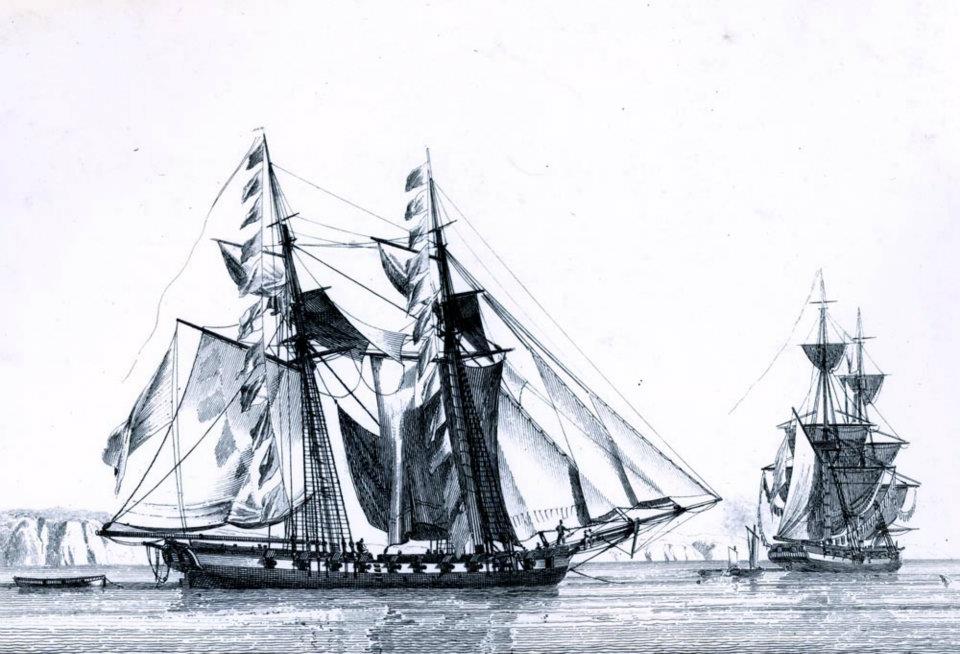 Oliver Hazard Perry’s schooner Revenge that wrecked on the rocks off Watch Hill in 1811 may have looked like the 12-gun schooner Enterprise shown here, which was originally built in Baltimore in 1799 (Naval History and Heritage Command)
Oliver Hazard Perry’s schooner Revenge that wrecked on the rocks off Watch Hill in 1811 may have looked like the 12-gun schooner Enterprise shown here, which was originally built in Baltimore in 1799 (Naval History and Heritage Command)
- March 19, 1821. An unidentified sloop was discovered sunk off Watch Hill Reef. No one was aboard and all but half on the mast was under water. No sign of the crew was found; they were all reported lost with the vessel.
- March 20, 1822. The sloop BOSTON, bound from New York for New Bedford, ran ashore on Watch Hill Reef. Part of the cargo and some of the rigging were saved but the hull went to pieces on the reef.
- March 18, 1835. The sloop ELOISA ran ashore in a snowstorm at Watch Hill. It had been bound from Warren for New York City with a cargo of sperm oil. A reward was offered for any of the oil casks that floated off the wreck; many were recovered, some as far away as Point Judith. But the vessel went to pieces.
- May 24, 1840. The schooner UNION ran ashore at night on Watch Hill Point. It was carrying the framework for another vessel when lost. It remained intact for ten days before going to pieces in a storm on June 3.
- April 10, 1841. The schooner EAGLE, bound from Boston for New York City with a cargo of pepper, ran ashore in a storm at the head of Watch Hill Reef. Though not confirmed, it was reported that EAGLE was a new or almost new vessel.
- May 12, 1847. The schooner ELIZABETH, bound from Baltimore for Fall River with 200 tons of iron, ran ashore in a storm on Watch Hill Reef. As was the case with many vessels that ran ashore on Watch Hill Reef, this 18-month old schooner ran ashore at night.
- December 1, 1849. The schooner DARIUS ran ashore on Watch Hill Beach, near the lighthouse. It had been bound from Albany for Boston with flour and bran on board. The schooner struck a reef near Watch Hill, sprung a leak, and was intentionally run ashore to save the crew and what they could of the cargo. The 20-year old vessel could not be saved; it went to pieces within a week.
- December 3, 1849. The schooner THAMES struck on Napatree Point two days after the schooner DARIUS, probably in the same storm. It sprung a leak and was run ashore on Watch Hill Beach, near the light. When wrecked, it had been bound from Boston for New York City with a cargo of hides, iron hoops. Although her bottom was broken up, some of the cargo and rigging was saved.
- November 11, 1852. The schooner PRESIDENT HARRISON sprung a leak after collision with the steamship OSCEOLA off Watch Hill. The crew was rescued by the steamer, but the schooner drifted ashore on Watch Hill Beach in the heavy southeast gale that prevailed. It went to pieces on the beach. It was bound from New York City for Harwich, Massachusetts, with a cargo of flour.
- March 11, 1853. The schooner PHILENA, bound from Portland, Maine for New York City with a cargo of sugar, oil cloth, domestic goods, etc., ran on Watch Hill Reef at 1 a.m. and was reported to have quickly gone to pieces. Ten years after this incident, salvage divers working on another wreck located the remains of this vessel, which had sunk next to the reef.
- December 29, 1854. The schooner MOUNT VERNON ran ashore on Watch Hill Reef in a snowstorm, while bound from Rockland, Maine for New York City with a cargo of lime. She sunk completely out of sight and the cargo was completely lost.
- August 9, 1855. The schooner HARD TIMES sprung a leak and sunk off Watch Hill Point. It had been bound from Gardiner’s Bay in Long Island for Bristol, Rhode Island with a cargo of seaweed. The crew took to the vessel’s small boat and made shore opposite Westerly, but the schooner drifted ashore and went to pieces.
- 1855. An unidentified schooner with a cargo of pig iron ran on the Spindle Reef at Watch Hill and was lost. Details of this incident have not yet been uncovered.
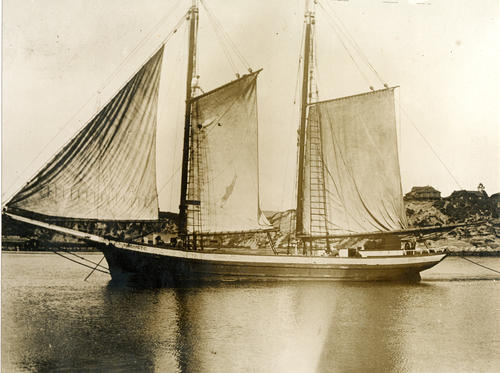
Most of the vessels that wrecked on the shores off Watch Hill were three-masted commercial schooners. Many may looked like the schooner Margaret C., out of Newport, circa 1900 (Providence Public Library Digital Collections)
- March 12, 1857. The schooner MARCIA, bound from New York City for Boston with a cargo of coal, ran ashore on Watch Hill Reef in a storm. The crew was rescued with great difficulty, but the vessel lost. It was reported that the cause of this wreck was that two or three buoys in the area had drifted from their stations into deep water.
- August 28, 1857. The sloop PINION struck on Watch Hill Reef and sunk in a storm. It had been bound from Port Ewen, New Jersey, for Taunton, Massachusetts, with 70 tons of coal on board. This incident took place at night in a storm. Members of the crew saved themselves by swimming to the beach.
- April 2, 1860. The brig WATSON, due to pilot error, ran on a rock near Watch Hill Beach . It had been bound from Philadelphia for Boston with a cargo of coal. No newspaper account of this loss has been found. The reference came from the book Westerly, Rhode Island and its Witnesses, 1626 to 1876, by Frederick Denison.
- November 23, 1860. An unidentified brig was driven ashore on Watch Hill Reef in a storm. No other facts are known about the vessel.
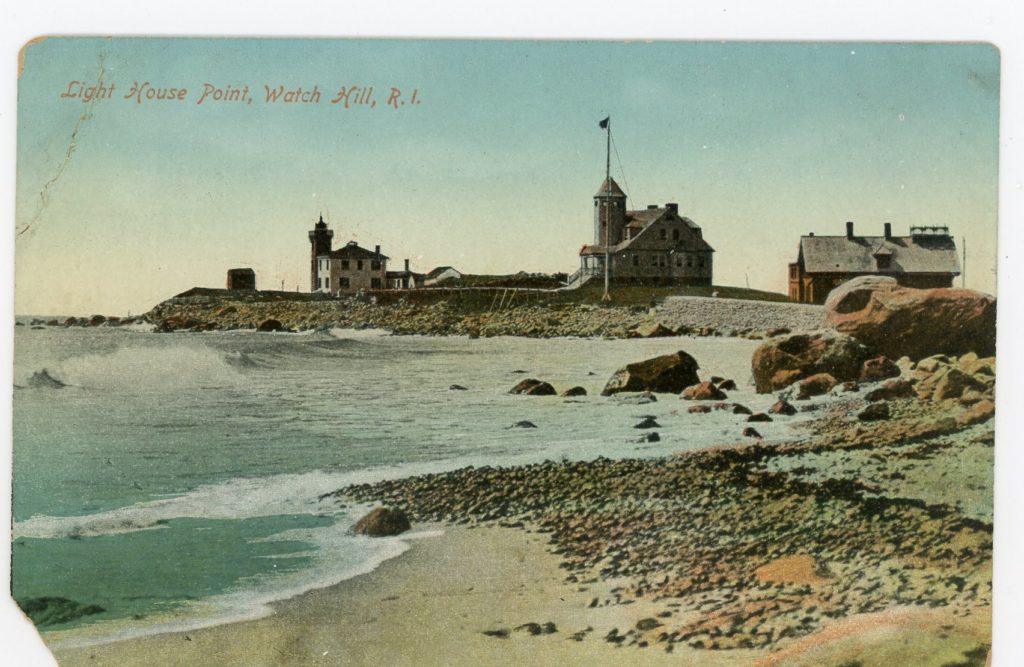
The Light House and Life Saving Station at Watch Hill, looking to the east (Sanford Neuschatz Collection)
- July 7, 1861. The schooner EMILY C. HORTON sunk off Watch Hill after colliding with the steamer METROPOLIS. EMILY C. HORTON had been bound from Port Ewan, New Jersey, for New Bedford, with a cargo of 142 tons of coal. The collision took place on a foggy night. The schooner was struck from the rear, an unusual occurrence. All hands saved themselves in the schooner’s small boat.
- July 15, 1861. The sloop STONY BROOK PACKET ran ashore on Watch Hill Reef. After slipping off the reef, it sunk nearby, a total loss. It has been bound from Elizabethport, New Jersey, for Providence, carrying 104 tons of coal.
- January 14, 1863. The schooner EBEN SAWYER ran ashore on Watch Hill Reef at 2 a.m. in heavy weather and became a total loss. At the time of the incident, it was bound from New Bedford for New York City with sperm oil, yellow metal, nails, etc. The cargo was valued at $70,000; only part of it was recovered. During that salvage operation, the wreckage of the schooners REVENGE (lost in 1811, see #5 above) and PHILENA (lost in 1853, see #15 above) were located.
- November 20, 1864. The brig DASHER ran ashore in fog on Watch Hill Reef. It had been southbound from Windsor, Nova Scotia, for New York City with a cargo of potatoes. The vessel was a total loss, but the crew was saved.
- December 10, 1864. The schooner LAURA CLINCH, bound from St. Andrews, New Brunswick, for New York City with lumber, ran ashore in a snowstorm on the east side of Watch Hill Point. The almost new schooner managed to stay together as she lay on the shore until July 1865, when it was reported that hopes were entertained that by lightering she would be gotten off the rocks.
- September 24, 1868. The schooner JOHN ADAMS ran ashore on Watch Hill Reef early in the morning. She had been bound from Rondout, New York, for Boston, carrying a cargo of cement. She was stripped of sails and rigging, but the rest proved a total loss.

The brig Toronto lies stranded off Watch Hill Light House in late November 1886. A life-saving line fired by a breaches buoy can be seen tied to the vessel. The crew of eight were rescued from the wreck by means of the breeches buoy but the vessel was eventually reduced to splinters on the rocky coast (Sanford Neuschatz Collection)
- October 3, 1870. The brig CHESAPEAKE ran ashore and became a total loss at Watch Hill. Where it was from and bound is unknown. She was most likely a victim of a storm or heavy weather.
- October 30, 1878. The schooner PHILANTHROPIST ran ashore and became a total loss on Watch Hill Reef. It had been bound from Pawtucket for New York City in ballast (with no cargo). This schooner was reported high and dry at low water. Given the time of the year and that the vessel was 50-years old, she was likely not worth the expense to salvage and repair.
- May 30, 1881. The schooner JULIA ELIZABETH ran ashore on Catumb Reef. Bound from Bangor, Maine for Orient, New York, she was carrying a cargo of lumber. She was believed to be impossible to save. Two months later a report in the news said the salvaged cargo of lumber was to be sold for the benefit of the salvage firm when the owners reneged on their agreement to pay for that salvage.
- January 4, 1882. The schooner MONMOUTH ran on Watch Hill Reef in a storm; the vessel was found abandoned by a life saver from the Watch Hill Life Saving Station. She later floated off the reef and was anchored about 1/3 of a mile from the Live Saving Station at Watch Hill but was found to be a total loss. She had been bound from Newport for New York City in ballast.
- October 18, 1884. The schooner Barge GUARD, bound from Hoboken for Boston with 1,500 tons of coal, struck a rock off Watch Hill Point and immediately filled with water. She became a total loss about 100-200 feet from the R2 buoy in Watch Hill Passage.
- November 30, 1885. The schooner MOLLIE PORTER, bound from Boothbay, Maine to New York City with a cargo of mackerel, ran ashore due to pilot error on Catumb Rocks about 6 a.m. on a cloudy November day. As the vessel ran aground at high tide, efforts to pull her off were of no avail and she went to pieces on the reef.
- February 15, 1886. The schooner LUCY A. BLOSSOM sunk in a heavy sea about a mile south of the Watch Hill Life Saving Station. She had been bound from South Amboy, New Jersey, for Newport, and carried 300 tons of coal. The crew abandoned the vessel shortly before she sunk.
- November 25, 1886. The brig TORONTO ran ashore in a storm on rocks about 200 yards northeast from the Watch Hill Life Saving Station – bound from Sydney, Nova Scotia for New York City with coal – the crew of eight were rescued from the wreck by means of a breeches buoy but the vessel was eventually reduced to splinters on the rocky coast.
- December 11, 1891. The schooner ALICE M. RIDGEWAY sprung a leak and was beached about ½ mile north of the Watch Hill Life Saving Station to prevent sinking. When it sprung the leak, it was bound from Providence for Greenport, New York with a cargo of salt. The lifesavers landed the crew and saved her sails, but the vessel became a total loss.
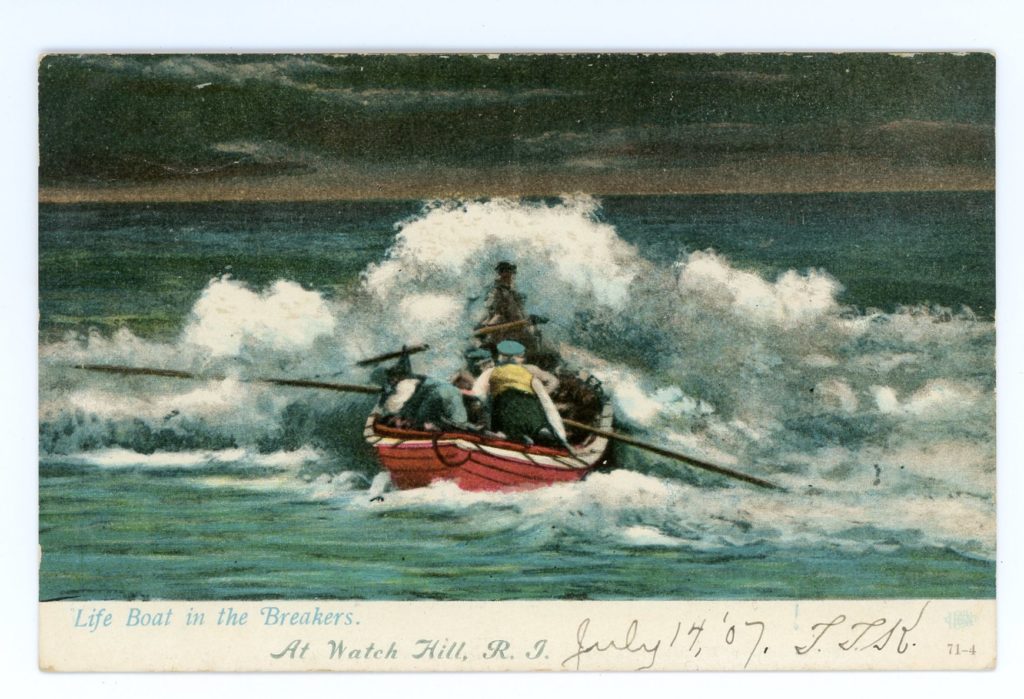
Life Savers from their station at Watch Hill trying to get past rough breakers to rescue the crew of a stranded vessel, circa 1890 (Sanford Neuschatz Collection)
- November 1892. An unidentified barge was reported ashore on Watch Hill and broken up before assistance could arrive. No further details of this incident have been discovered.
- October 23, 1896. The three-masted schooner MAGGIE ABBOTT ran ashore due to pilot error between the bell buoy and spindle on Watch Hill Reef. Bound from St. John, New Brunswick, for New York City, it carried a cargo of laths and deals. Firmly aground and leaking, the crew was removed by the lifesavers, but the vessel was doomed and in less than two weeks went to pieces.
- May 25, 1898. The schooner LAUREL ran ashore in fog on Catumb Rocks. Bound from Blue Hill, Maine, for Newark, New Jersey, it carried 120 tons of paving stones and 38 tons of cut granite. Cargoes like stone were often the primary contributing factor in losses such as this one. The captain and crew of the schooner were safely taken off the wreck before it broke up.
- March 31, 1901. The schooner GEORGE A. PIERCE, on its way from Newport to New York City without cargo, ran ashore in a heavy squall on Catumb Rocks. Due to the presence of a heavy sea from the gale, the crew remained on the wrecked vessel most of the night before being rescued by the life savers.
- September 4, 1907. The barge R.R. NO. 701 ran ashore in a squall on the rocks off Watch Hill Point. It had been bound from New London for Providence with 676 tons of coal on board. NO. 701 was the third in a string of four barges. Trouble began for the string when the tide carried the barge onto Gangway Rock at which time the hawser to the last two barges parted and they both subsequently ran ashore. One was removed later by the Army Corps of Engineers but this one became a total loss.
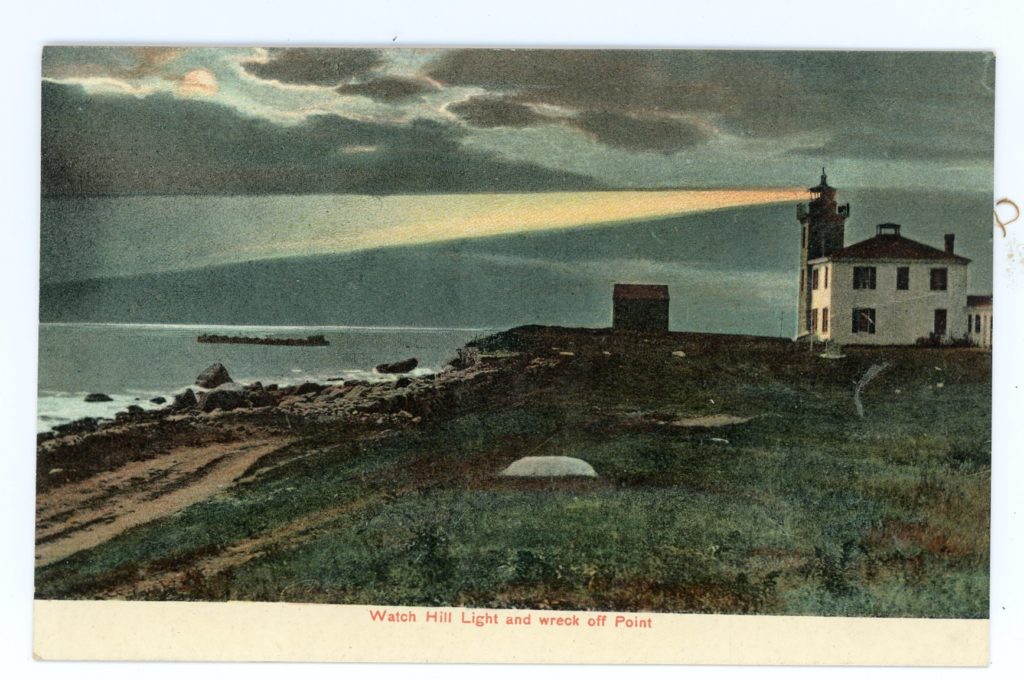
A beam of light from the Watch Hill Light House cuts through the night, while the remains of a wreck can be seen close off shore, circa 1890 (Sanford Neuschatz Collection)
- April 28, 1916. Canadian schooner BEATRICE L. CORKUM ran ashore and sunk on Catumb Reef due to pilot error. It had been bound from Liverpool, Nova Scotia for New York City with lumber. The captain and crew of the schooner were taken off the wreck by life savers at the Watch Hill Life Saving Station, but the vessel was lost.
- June 28, 1918. The steamship ONONDAGA mistook the light at Watch Hill and ran aground next to Sugar Reef, Watch Hill. It was bound from Boston for Charleston, South Carolina, with a miscellaneous cargo when the accident occurred. The freighter sank in relatively shallow water. In ordinary circumstances, the freighter would have chosen a route away from the dangerous coastline, but due to the threat of German submarine activity (World War I had not ended yet), her master chose to travel the more dangerous inner route and paid the ultimate price for that decision. The entire 35-man crew was saved.
- August 24, 1918. The fishing steamer GEORGE HUDSON ran ashore and sunk in fog on Watch Hill Reef. It was bound from New Jersey for Mystic, Connecticut, with a cargo of 1,000 barrels of menhaden. As with many losses in this area, fog was the primary cause of the loss.
- September 1920. The fishing sloop HATTY LAWRY ran ashore on Watch Hill Reef. The reports of this incident centered on the escape of several thousand lobsters, the cargo at the time of the stranding. It is not known to what port the sloop was headed.
- July 18, 1928. The diesel-screw fishing boat AVE MARIA sunk off Watch Hill after a collision. There are no reports stating where this fishing boat was from or headed at the time of the collision, nor is there a name for the vessel which sent her to the bottom. What is known is that she was a practically new vessel and was based at Friendship, Maine. She was listed as a total loss.
- August 1, 1946. The gas-screw fishing boat AKBAR foundered and sunk off Watch Hill Point. This vessel was described as a fishing boat, but it was owned by the New England Diving Company; thus, it is uncertain whether she was used for fishing or salvage purposes. She was thirty-one years old at the time of her loss.
- September 18, 1953. The diesel-screw yacht CARMAC ran ashore due to pilot error on Watch Hill Reef. Where she was from or bound on her final voyage is unknown. The yacht carried fifteen persons—thirteen crewmen and two passengers. A salvage crew was hired to pull the yacht off the reef but after surveying the wreck, they declined to make an attempt as it expense of the task was expected to exceed the value of the damaged vessel.
Since the loss of the CARMAC, no more vessels have been reported as lost or wrecked at Watch Hill Point or on the neighboring reefs. It is still possible that some small, local vessels have been lost since 1953, but those would be difficult to substantiate with contemporary reports.
As this series of articles continue, the next most prolific area for totally lost vessels in Rhode Island waters is Point Judith. Although a complete analysis of the wrecks that have occurred at Point Judith is not yet complete, to date there are at least forty-four known totally lost vessels in the immediate vicinity of the point.
[Banner image: The brig Toronto lies stranded off Watch Hill Light House in late November 1886. A life-saving line fired by a breaches buoy can be seen tied to the vessel. The crew of eight were rescued from the wreck by means of the breeches buoy but the vessel was eventually reduced to splinters on the rocky coast (Sanford Neuschatz Collection)]



